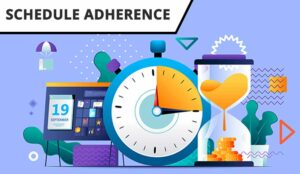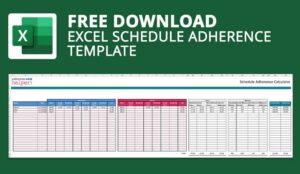Here are 15 tips to help you improve attendance and adherence in your contact centre.
1. Buddy-up your agents to control who stays on the floor
Use a “tagging” system so that your agents can only go on their break when their buddy comes back.
This should help to ensure that too many people aren’t off the floor at any one time, and that they keep to their set break times.
With thanks to Heather
2. Introduce annualised hours to help with lateness
Introduce annualised hours to help stop your agents arriving late and/or spending too much time on their breaks.
With thanks to Jamie
3. Show upper management the financial implications
You definitely need buy-in from management. To help do this, our resource team put together a ‘financial cost of non-adherence’ presentation for the management team.
With thanks to Donna
4. Report on ‘log-on live time’ and ‘activity per agent’
Using access security and system action category tracking, report on ‘log-on live time’ and ‘activity per agent’ against the tasks required to be done.
With thanks to Sharon
5. Promote an ‘absence makes your friends work harder’ ethos
To help encourage good attendance from all of our staff, we promote an ‘absence makes your friends work harder’ ethos.
With thanks to Donna
6. Aim to achieve a target that you have met previously
We have a “bobble hat theory” in terms of targets; we aim to achieve a target that we have met previously so as not to be unrealistic, and then increase accordingly as performance improves.
With thanks to Jamie
For more on setting targets and keeping track on attendance across the contact centre, read our article: How to Calculate Absenteeism
7. Show your agents the impact of their non-adherence
Advisors need to understand the impact their non-adherence/attendance has on colleagues and the ability to meet customer demand.
The best way to encourage adherence is to fully explain the effect and reasoning behind any constraints placed on the agents.
This helps them to be invested in and feel responsible for their adherence.
With thanks to Alexander and Chris
8. Give your agents break timers
Our advisors use break timers and we find that it helps to keep them on track.
With thanks to Nicola
9. Make sure your supervisors understand
We have found that our supervisors don’t understand the concept of adherence well enough, and this leads to uncertainty when trying to address problematic agents.
It is something we’re now working on amending.
With thanks to Jason
10. Use “break balls” to control how many agents leave the floor
Use “break balls” so that you can control how many agents leave the floor at any one time.
With thanks to Jamie
11. Start seeing adherence as part of the bigger picture
Adherence and scheduling should not be seen as an isolated area to be managed but must form part of the business ethos.
To encourage this ethos, you should have clear expectations regarding required behaviours. This should then be enforced by managers at all levels, who have the confidence to have real-time discussions with agents displaying negative behaviour.
In addition to this, visible praise should be given to individuals and teams who are meeting or exceeding company expectations.
With thanks to Robert
For more measuring and managing adherence in the contact centre, read our article: How do I Calculate… Schedule Adherence?
12. Have a robust sickness management process
Have a robust sickness management process and don’t be afraid to dismiss where necessary, as this has a powerful effect on the floor!
With thanks to Jason
13. Try using a cash incentive
We had an incentive that involved teams working against each other for a month for a cash prize of £500.
We saw great levels of adherence over that month. However, once the incentive ended, things went back to normal.
With thanks to another one of our readers
Find out how to make the most of your incentive rewards in our article: How to Improve Your Employee Reward Schemes – With Examples
14. Use coaching sessions to monitor and praise adherence
We use our agents’ coaching slots to monitor and communicate adherence to the team in real time, and then offer feedback during team meetings.
This has gained buy-in from colleagues, celebrated success and highlighted problem areas.
With thanks to Jo
15. Display performance statistics to the entire call centre
We have live call monitoring on plasma screens which can be seen by advisors and team managers.
They are colour coded red and green to highlight those who are performing and those who are not.
With thanks to Nicola
For more on the topic of improving schedule adherence, read our articles:
Author: Megan Jones
Published On: 5th Feb 2014 - Last modified: 11th Dec 2020
Read more about - Workforce Planning, Adherence, Incentives




































What are annualised hours?
What are annualised hours?
Please can the writer explain the Bobble Hat idea more fully? Sounds interesting.
p.s. we place great emphasis on Wellbeing and pre-emptive action on robust sickness absence management (e.g. improvement plans can start after only 2 days sickness absence) and are finding this really working at present.
Hi Sally, we have sent a request regarding the bobble hat idea and still waiting on a reply
I also suggest informing your agents of your own (manager/team leader) attendance year to date. Lead by example.
Last year, we implemented an incentive plan that we have found both successful and motivating. This is based on both attendance and active minutes on the phone per hour/day.
Example: if they consistently complete X mins or more every hour of their shift, they are eligible to be paid by the minute at the current rate (this usually exceeds their hourly by $1-$3!).
However, if they miss a day in a pay period, they will only receive half of this bonus amount. If they miss two or more days, they receive none of it.
The idea here is to promote consistency in both attendance and performance.
Quick question from a best practice perspective.
I am working closely with a call center leadership team that includes Attendance absences as a factor in the representative’s Adherence results.
To me this is a “double-ding” as you cannot have low adherence for a shift that you did not come in to work.
Thoughts?
If a company does all of these tips already and attendance and adherence is still a problem, do you have any other suggestions. I would really like to get some ideas in order to improve my team’s attendance.
Thank you,